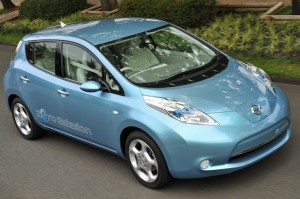Google, Inc. has deployed more than 70 Coulomb Technologies charging stations at its worldwide headquarters in Mountain View, CA. Over 100 employees who own electric cars use the charging stations. The stations (EVSE) are also used by the company’s growing car sharing program for Googlers (GFleet), which includes Chevrolet Volts, Nissan LEAFs and Toyota Prius Plug-in Hybrids.
Many employees bought their own electric cars after using LEAFs and Volts in the GFleet. Employees who use transit get GFleet priority.
With plans for 250 more charging stations on its campus, and a goal to make 5 percent of its campus parking EV-ready, Google’s installation is the largest workplace charging installation for electric vehicles in the country. Much of the charging is done with renewable energy, including Google’s solar covered parking. No coal power is used in charging vehicles. Google has invested over one billion dollars in renewable energy, accelerating development of 1.7 GW of RE.
“By investing in new, green transportation technologies, Google is making a significant contribution to reducing our own greenhouse gas emissions,” said Rolf Schreiber technical program manager, Electric Transportation, at Google. “Our EVs and charging stations are part of our broader green transportation system that includes biodiesel shuttles that Googlers use to commute to work instead of driving their own cars. But we’re only one company among many, so we hope our green transportation initiatives serve as a model for other companies to incorporate sustainability programs into their own workplaces.”
Google manages its charging stations via the ChargePoint Network, the world’s largest network of charging stations and EV charging applications. The following workplace charging features are available through Coulomb’s ChargePoint Network:
· Controlled access: Via an online portal and smartcards, customers can control who accesses their charging stations (employees or guests), to control costs, eliminate electricity theft, and optimize station use.
· Measuring performance of green initiatives: Online station management provides tracking and reporting of energy usage, greenhouse gas and gasoline savings data. Reports are displayed by graphs that can be filtered by day, week, month, station attributes and energy usage/GHG range. Customers can also export their station data and combine the data with other system for further corporate sustainability analysis.
· Network Operations: The ChargePoint Network provides 24/7 station network monitoring to ensure network services are always available, Over the Air (OTA) station software upgrades to accommodate future advancements without onsite service, and the ability to tie into energy, building and other business management systems.
· Driver Services: Customers have access to the ChargePoint Network’s 24/7 driver telephone assistance, e-mail or text message driver notification alerts for charging session interruption or charging completed, and individual driver portals to customize notifications, track their energy usage and greenhouse gas savings, view charging history, and have access to the largest network of public charging stations in the world at www.mychargepoint.net
· Cost-saving utility programs and incentives: Charging stations contain utility-grade meters and the ability to communicate with other smart grid systems, enabling demand response, time-of-use pricing, and other smart grid programs provided by local utilities.
The company has been working over the last several years to deploy and experiment with new green transportation technologies.
· In 2007, Google launched RechargeIT, an initiative aimed at accelerating the adoption of electric vehicles.
· Google’s biodiesel campus shuttles use the latest clean diesel technology, reducing emissions 80 percent over engines from just a few years ago.
· Placing solar panels on buses to provide pre-cooling without having to run the engines.
· More than 3000 Googlers ride a shuttle bus to the company’s Mountain View headquarters every day.
· Google’s ChargePoint workplace charging system encourages more and more employees to commute using electric transportation.
Google’s transportation initiatives save 5,400 tons of CO2e emissions this year. Google is just getting started.
Google makes innovative use of electric vehicles and charging stations. For employees, Google took an early lead in converting Toyota Prii (yep that’s the official plural of Prius) to be plug-in hybrids. Then Google installed beautiful solar covered parking including charge stations so that electric cars can be charged with sunlight.
At its headquarters, Google is now showing us how to charge hands-free. No plug. No cord. Using Evatran Plugless Power’s inductive charging system, one of Google’s maintenance short-range EVs parks in close proximity of the charger and charging begins. The Evatran unit is Level 2 (7.7 kW, 240V at 32A). The light EV was converted to use the inductive charging.
Google is also conducting other important pilots including testing the new Toyota Prius Plug-in, not a conversion, but the 2012 model from Toyota. Soon, Google will be testing the Honda Fit Electric and other plug-in cars. Several Google founders drive Tesla Roadsters. Google founders Larry Page and Sergey Brin are Stanford University grad student “drop-outs.” They don’t regret the decision to make changing the world a priority over getting their PhDs.


Google has set the bar high for a lot of Fortune 500 corporations to follow; Google has invested $1billion in renewable energy projects which is massive for a search engine/ad company; compare that to Chevron touting they have invested millions in renewable energy which is a pittance for an energy company.
Once the economy is back on track the young, smart and eco-savvy workers are going to go to those companies who have a green plan to help their employees reduce their carbon footprint at work and home. The pretenders will lag behind.